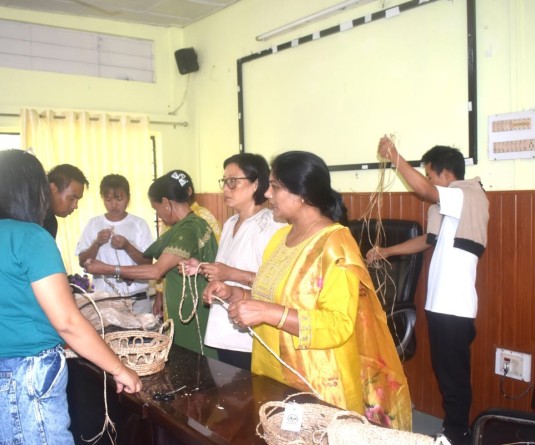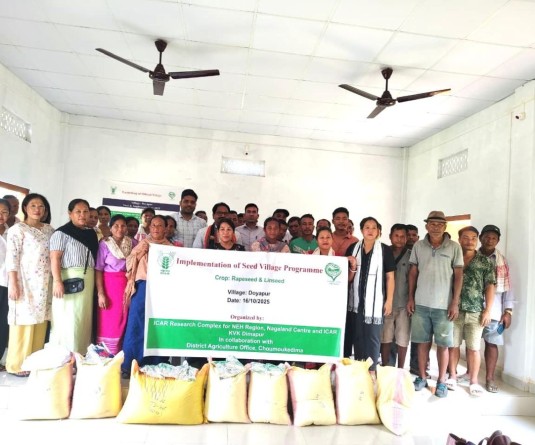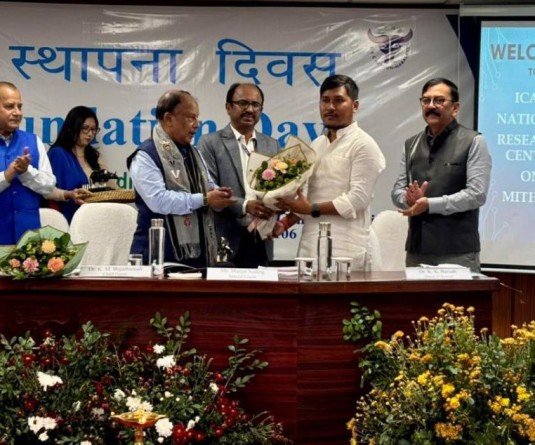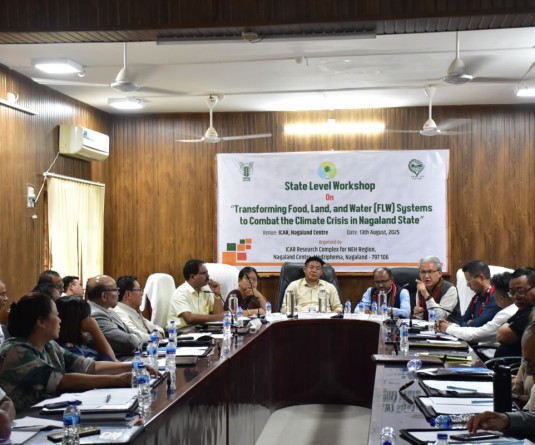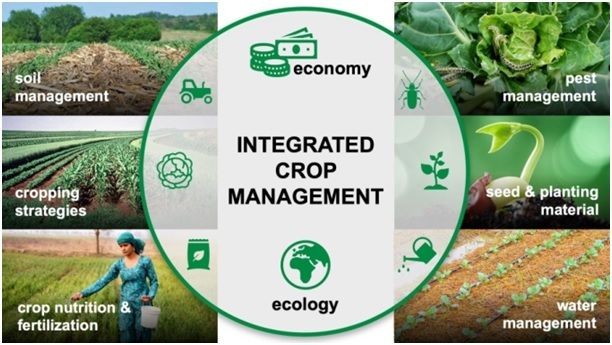
The forage production per unit area is a consequence of the interactions between genotypes and environment. A crop environment may be regarded as having two components, the gross environment, which takes into account the environmental factors affecting crop growth, and the current environment, which takes into account the general soil and atmospheric conditions outside the crop and also the changes caused by the plant community. However, the phenomenal increase in productivity is possible mainly through better varieties, seeds, fertilizers and agronomic technology. The package of practices Maize fodder crops are given below:
Maize (Zea mays)
Maize in India ranks fifth in total area and third in total production and productivity. The level of production has to be raised because of substantial demand as food, feed and poultry feed.
Season: Fodder Maize can be grown in all seasons viz; kharif (monsoon), post monsoon, rabi (winter) and spring. During rabi and spring seasons to achieve higher yield at farmer’s field, assured irrigation facilities are required. During kharif season it is desirable to complete the sowing operation 12-15 days before the onset of monsoon. However, in rainfed areas, the sowing time should be coincided with onset of monsoon. Optimum time of sowing for kharif is last week of June to first fortnight July, for rabi - last week of October for inter cropping and up to 15th of November for sole crop and for spring, First week of February. It should be taken care that the flowering should not coincide either with rain or high RH and the maturation should coincide with dry weather. The temperature of 37°C is favourable for better seed setting.
Varieties: Some cultivars require 60-70 days to mature; others require 100-110 days to mature. Grain colour also varies from yellow to orange to white. Mainly flint types are preferred.
Soil: Very sandy soils rapidly respond to management practices than those that are fine textured. Intermediate texture of loam to silt loam in surface horizon and little higher content of clay as silt loam to silty clay loam in subsoil is the most ideal. Soil pH of 7.5-8.5 supports good crop growth, as the crop is grown under rainfed conditions it is important that soil must have good water holding capacity, with proper drainage system to avoid waterlogging conditions.
Seed rate and sowing time: About 50-60 kg seed would be needed to sow one hectare. Seed should be grown 5 cm deep into soil for good germination, seedling growth and vigour. Transplanting should be avoided as the plant cannot cope up with main crop stand. It is preferred to sow 10-15 days before start of rain which will give 15% higher yield.
Manures and fertilizers: A balanced application of 60-120 kg N, 40-60 kg P and 40kg K/ha is recommended. Early maturing varieties require less quantity than full season maturity crops. It is also advisable to apply 20 kg zinc sulphate /ha along with basal dose of fertilizer. One-fourth of nitrogen and entire quantity of phosphorus, potassium and zinc should be applied 5-7 cm deep before sowing. Rest of the doses are applied at knee-high stage and after emergence of flag leaf but before tassel emergence.
Plant population: A population of 65,000-70,000 plants /ha at harvest is optimum for realizing higher yields. For attaining desired level of plant density, a row to row and plant to plant spacing of 75 cm × 18 cm or 60 cm × 22 cm should be maintained.
Irrigation: To ensure high and stable yield, it is desirable to give 1 or 2 irrigations at critical stages. Flowering and grain-filling stages are most critical; the crop should be irrigated at these stages, if rain fails.
Intercropping: Short-duration varieties of pulse crop, oilseed crop and vegetable can successfully be grown as intercrop. A ratio of 2 rows of maize with 1 row of other desired crop can be adopted.
Harvesting: In absence of irrigation, crop can be harvested at any stage. At pre-flowering it can be used as fodder and at dough stage green ear and stover may be used for cattle. For fodder purpose, the milk to early dough stage is preferred for higher yield and protein content. For silage, late dough stage is preferred.
Berseem (Trifolium alexandrinum )
Berseem is the prominent legume fodder crop and it makes the most digestible and palatable green fodder to the cattle and especially milch animals are very much benefited with berseem. It provides fodder with high tonnage over a long period from November to May in 5 - 6 cuts. It has 20-24% crude protein and 70% dry matter digestibility. It is very good soil builder and adds about 0.38-0.46% organic carbon, 15 -26 kg available phosphorus and 45 kg available nitrogen to the soil.
Climatic requirements: Berseem prefers dry and cool climate for its proper growth. Its regenerative growth is retarded during severe cold or frosty period or at temperature above 40°C. It can be grown successfully in areas which receive annual rainfall of 150-250 cm or even lower but the irrigation must be assured.
Soil: Berseem can be grown on all types of soils except very light sandy soils. Well-drained clay loam soils rich in calcium and phosphorus are ideally suited for its cultivation. The crop can be grown successfully on alkaline soils having good water retention capacity. The crop can tolerate mild acidity also.
Field preparation: Seeds being very small, berseem requires a fine seedbed. One deep ploughing with soil turning plough and 2 harrowings are essential. Field may be laid out in to smaller beds of convenient size according to topography and source of irrigation water.
Sowing time: After the arrest of rains, sowing of berseem can be done from last week of September to first week of December in North West to Eastern and Central India. Time of sowing berseem is ideal when mean day temperature is 25° C, which is recorded mostly in the first to third week of October in north India.
Seed rate: Optimum seed rate is 25 kg/ha, which may be increased up to 35 kg in early or late sown conditions. For yield compensation in first cutting, 1.5 kg mustard should be sown along with berseem.
Seed treatment: Seed treatment with Rhizobium culture is essential, when the berseem crop is to be grown first time in the field. Before treating the seed, it should be first soaked into fresh water for about 8-12 hours. For better sticking of culture with seed, the culture is prepared with jaggery. About 1.5 litres of water is mixed with 150 g of jaggery and boiled. After cooling, 2.5 packets of berseem culture are mixed with it and then seed is well mixed and dried in a cool shady place.
Sowing method: There are two methods for sowing of berseem i.e. dry and wet bed. For satisfactory germination and good plant stand, wet method is better. Seed should be sown in beds of convenient size by broadcast method after flooding the beds with 5-6 cm deep water. Before sowing seeds, the water in the beds should be stirred thoroughly with the help of puddler or rake so as to break the clods and capillary to avoid leaching during successive irrigations. Crop should be re-irrigated after 5-6 days of sowing when germination is complete.
Manures and fertilizers: Berseem, being a legume crop, requires less nutrient replenishment in the soil. For obtaining good yield, 20 kg N and 80 kg P2O5/ha should be applied as basal dose. In saline or light textured soil, addition of 20 tonnes of well decomposed FYM is beneficial. FYM may be excluded if the previous crop of the rotation was liberally manured and fertilized.
Weed control: Chicory, the associated weed of berseem should be eliminated for higher herbage and good quality fodder.
Application of Fluchloralin @ 1.2 kg a.i./ha at pre planting stage controls the chicory and other weeds effectively. However, floating of berseem in 10% common salt is effective against chicory only.
Harvesting: First cutting should be taken at 50-55 days after sowing of crop. The subsequent cuttings should be taken at 25-30 days interval. The number of cuts depends upon rate of growth and temperature during the life cycle of the crop.
Yield: A good berseem crop can give 100-120 tonnes/ ha green fodder and 15-20 tonnes/ha dry fodder.
Article contributed by Dr Bendangla Imsong, Chief Technical Officer (Plant Breeding); Dr Ebibeni Ngullie, hief Technical Officer (Animal Science); Dr Phool Kumari, Senior Scientist and Head Krishi Vigyan Kendra, Dimapur ICAR (RC) for NEH Region, Nagaland Centre
Best integrated crop management practices
Dr Hannah Krujia
CTO Agronomy KVK Phek, Nagaland
Integrated Crop Management (ICM) is the best way for enhancing productivity. It combines the best of traditional methods with suitable modern technology, balancing the economic production of crops with positive environmental management. ICM practice plays an important role in producing higher yield. It also helps in the maintenance of soil structure and fertility, improvement of soil fertility, prevent build-up of pests, diseases and weeds, prevent damage to soil, water, avoid loss of biodiversity and decrease environmental damage and production cost.
Integrated Crop Management (ICM) is a pragmatic approach to agriculture, at the same time offers a holistic approach to crop management which is site specific and involves the integration of the following:
• Soil health - This focuses on maintaining soil structure, stability, and fertility. It is the central element of an ICM plan.
• Crop rotation - A diverse crop rotation can enhance and maintain soil fertility as well as reduce the impact of weeds, pests, and diseases by interrupting pest and disease life cycles.
• Crop nutrition - Crop nutrition involves a fertilization plan designed to match the major nutrients required by the growing crops. It also includes regular soil analysis to determine the nutrients available in the soil.
• Environment - ICM involves planning a program for the entire farm, including the land that is not used for farming. This is done to conserve a certain degree of biodiversity.
• Energy - ICM aims to make energy use as efficient as possible. It prioritizes exploring renewable energy options and saving energy through in-depth analysis of farm operations to determine the proportion of fuel spent on each level.
• Waste management - Energy resources also include waste disposal, with the primary aim to recycle maximum amount of material.
• Crop protection - Crop protection includes protecting crops from weeds, pests, and diseases. It is a major component of ICM practices.
ICM holds a philosophy of working with nature as opposed to working against nature and is the future of sustainable, profitable agriculture, offering a possible way of preparing for the challenges of an increased population. Integrated crop management practices enable farmers to run a profitable business with responsibility and sensitivity towards the environment. Farming needs to embrace holistic farming practices such as those found in ICM to be able to increase yields and maximize every resource available to a farmer. This will ensure viability for the farmer as well as a sustainable farming system.


